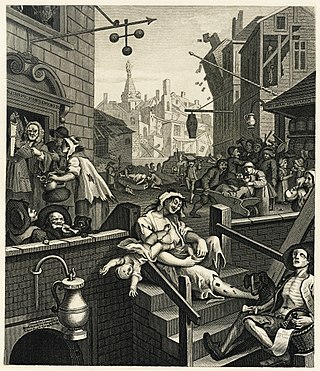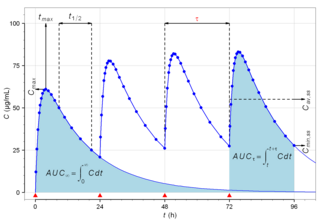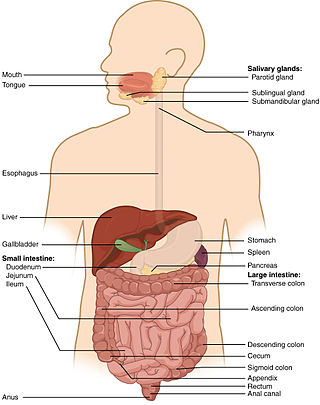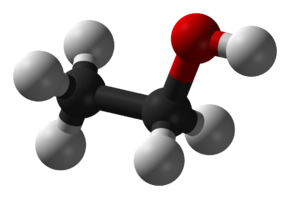
Alcohol intoxication, also known in overdose as alcohol poisoning, commonly described as drunkenness or inebriation, is the behavior and physical effects caused by a recent consumption of alcohol. In addition to the toxicity of ethanol, the main psychoactive component of alcoholic beverages, other physiological symptoms may arise from the activity of acetaldehyde, a metabolite of alcohol. These effects may not arise until hours after ingestion and may contribute to the condition colloquially known as a hangover. The term intoxication is commonly used when large amount of alcohol is consumed along with physical symptoms and deleterious health effects.

Alcohol by volume is a standard measure of how much alcohol is contained in a given volume of an alcoholic beverage. It is defined as the number of millilitres (mL) of pure ethanol present in 100 mL of solution at 20 °C (68 °F). The number of millilitres of pure ethanol is the mass of the ethanol divided by its density at 20 °C (68 °F), which is 0.78945 g/mL. The alc/vol standard is used worldwide. The International Organization of Legal Metrology has tables of density of water–ethanol mixtures at different concentrations and temperatures.

Forensic toxicology is a multidisciplinary field that combines the principles of toxicology with expertise in disciplines such as analytical chemistry, pharmacology and clinical chemistry to aid medical or legal investigation of death, poisoning, and drug use. The paramount focus for forensic toxicology is not the legal implications of the toxicological investigation or the methodologies employed, but rather the acquisition and accurate interpretation of results. Toxicological analyses can encompass a wide array of samples. In the course of an investigation, a forensic toxicologist must consider the context of an investigation, in particular any physical symptoms recorded, and any evidence collected at a crime scene that may narrow the search, such as pill bottles, powders, trace residue, and any available chemicals. Armed with this contextual information and samples to examine, the forensic toxicologist is tasked with identifying the specific toxic substances present, quantifying their concentrations, and assessing their likely impact on the individual involved.

A breathalyzer or breathalyser is a device for measuring breath alcohol content (BrAC). The name is a genericized trademark of the Breathalyzer brand name of instruments developed by inventor Robert Frank Borkenstein in the 1950s.

Alcohol tolerance refers to the bodily responses to the functional effects of ethanol in alcoholic beverages. This includes direct tolerance, speed of recovery from insobriety and resistance to the development of alcohol use disorder.

Biological half-life is the time taken for concentration of a biological substance to decrease from its maximum concentration (Cmax) to half of Cmax in the blood plasma. It is denoted by the abbreviation .
Plasma osmolality measures the body's electrolyte–water balance. There are several methods for arriving at this quantity through measurement or calculation.

A hangover is the experience of various unpleasant physiological and psychological effects usually following the consumption of alcohol, such as wine, beer, and liquor. Hangovers can last for several hours or for more than 24 hours. Typical symptoms of a hangover may include headache, drowsiness, concentration problems, dry mouth, dizziness, fatigue, gastrointestinal distress, absence of hunger, light sensitivity, depression, sweating, hyper-excitability, irritability, and anxiety.

tert-Amyl alcohol (TAA) or 2-methylbutan-2-ol (2M2B), is a branched pentanol.

The short-term effects of alcohol consumption range from a decrease in anxiety and motor skills and euphoria at lower doses to intoxication (drunkenness), to stupor, unconsciousness, anterograde amnesia, and central nervous system depression at higher doses. Cell membranes are highly permeable to alcohol, so once it is in the bloodstream, it can diffuse into nearly every cell in the body.
Alan Wayne Jones is a researcher and scholarly writer on the subject of forensic toxicology and human physiology relating to alcohol consumption. Jones was born in Pontypridd, Wales, UK, but worked for most of his career in Sweden.
In the field of pharmacokinetics, the area under the curve (AUC) is the definite integral of the concentration of a drug in blood plasma as a function of time. In practice, the drug concentration is measured at certain discrete points in time and the trapezoidal rule is used to estimate AUC. In pharmacology, the area under the plot of plasma concentration of a drug versus time after dosage gives insight into the extent of exposure to a drug and its clearance rate from the body.

Phosphatidylethanols (PEth) are a group of phospholipids formed only in the presence of ethanol via the action of phospholipase D (PLD). It accumulates in blood and is removed slowly, making it a useful biomarker for alcohol consumption. PEth is also thought to contribute to the symptoms of alcohol intoxication.

Drunk driving is the act of driving under the influence of alcohol. A small increase in the blood alcohol content increases the relative risk of a motor vehicle crash.

Auto-brewery syndrome(ABS) (also known as gut fermentation syndrome, endogenous ethanol fermentation or drunkenness disease) is a condition characterized by the fermentation of ingested carbohydrates in the gastrointestinal tract of the body caused by bacteria or fungi. ABS is a rare medical condition in which intoxicating quantities of ethanol are produced through endogenous fermentation within the digestive system. The organisms responsible for ABS include various yeasts and bacteria, including Saccharomyces cerevisiae, S. boulardii, Candida albicans, C. tropicalis, C. krusei, C. glabrata, C. kefyr, C. parapsilosis, Klebsiella pneumoniae, and Enterococcus faecium. These organisms use lactic acid fermentation or mixed acid fermentation pathways to produce an ethanol end product. The ethanol generated from these pathways is absorbed in the small intestine, causing an increase in blood alcohol concentrations that produce the effects of intoxication without the consumption of alcohol.

Flubromazepam is a benzodiazepine derivative which was first synthesized in 1960, but was never marketed and did not receive any further attention or study until late 2012 when it appeared on the grey market as a novel designer drug.

Methanol toxicity is poisoning from methanol, characteristically via ingestion. Symptoms may include a decreased level of consciousness, poor or no coordination, vomiting, abdominal pain, and a specific smell on the breath. Decreased vision may start as early as twelve hours after exposure. Long-term outcomes may include blindness and kidney failure. Blindness may occur after drinking as little as 10 mL; death may occur after drinking quantities over 15 mL.

Alcohol, sometimes referred to by the chemical name ethanol, is classified by the World Health Organization (WHO) as a toxic, psychoactive, dependence-producing, and carcinogenic substance. It is one of the most widely consumed psychoactive drugs in the world and falls under the depressant category. While the terms "drug" and "medicine" are sometimes used interchangeably, "drug" can have a negative connotation, often associated with illegal substances like cocaine or heroin, which is why the alcohol industry may argue that "alcohol is not a drug". The normalization of alcohol consumption, along with past misconceptions about its health benefits, also promoted by the industry, further reinforces the mistaken idea that it isn't a "drug". Even within the realm of scientific inquiry, the common phrase "drugs and alcohol" persists. However, this phrasing implies that alcohol is somehow separate from other drugs. Social workers address this issue by using the term "Alcohol and Other Drugs". Paradoxically, despite being legal, alcohol, scientifically classified as a drug, has demonstrably been linked to greater social harm than most illegal drug.

N-Acetyltaurine (NAcT) is an endogenous metabolite. Biochemically, N-acetyltaurine is formed as a result of an acetylation of taurine. The main substrate for this reaction is acetate. An increase of endogenous N-acetyltaurine concentrations was observed after the consumption of alcohol and after extended physical activity (ketoacidosis).
The pharmacology of ethanol involves both pharmacodynamics and pharmacokinetics. In the body, ethanol primarily affects the central nervous system, acting as a depressant and causing sedation, relaxation, and decreased anxiety. The exact mechanism remains elusive, but ethanol has been shown to affect ligand-gated ion channels, particularly the GABAA receptor.
























